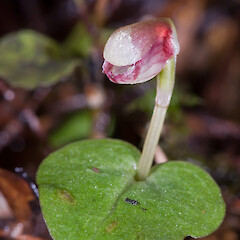Corybas rotundifolius
Common name
helmet orchid
Synonyms
Corysanthes matthewsii Cheeseman, Corysanthes rotundifolia (Hook.f.) Hook.f., Nematoceras rotundifolia Hook.f., the New Zealand plant has also been confused with the Australian Corybas unguiculatus (R.Br.) Reichb.f.; Anzybas rotundifolius (Hook.f.) D.L.Jones et M.A.Clem.
Family
Orchidaceae
Flora category
Vascular – Native
Endemic taxon
Yes
Endemic genus
No
Endemic family
No
Structural class
Orchids
NVS code
The National Vegetation Survey (NVS) Databank is a physical archive and electronic databank containing records of over 94,000 vegetation survey plots - including data from over 19,000 permanent plots. NVS maintains a standard set of species code abbreviations that correspond to standard scientific plant names from the Ngä Tipu o Aotearoa - New Zealand Plants database.
ANZROT
Chromosome number
2n = 36
Current conservation status
The conservation status of all known New Zealand vascular plant taxa at the rank of species and below were reassessed in 2017 using the New Zealand Threat Classification System (NZTCS) – more information about this can be found on the NZTCS website. This report includes a statistical summary and brief notes on changes since 2012 and replaces all previous NZTCS lists for vascular plants.
Please note, threat classifications are often suggested by authors when publications fall between NZTCS assessment periods – an interim threat classification status has not been assessed by the NZTCS panel.
- Conservation status of New Zealand indigenous vascular plants, 2017 . 2018. Peter J. de Lange, Jeremy R. Rolfe, John W. Barkla, Shannel P. Courtney, Paul D. Champion, Leon R. Perrie, Sarah M. Beadel, Kerry A. Ford, Ilse Breitwieser, Ines Schönberger, Rowan Hindmarsh-Walls, Peter B. Heenan and Kate Ladley. Department of Conservation. Source: NZTCS and licensed by DOC for reuse under the Creative Commons Attribution 4.0 International licence.
2017 | Not Threatened | Qualifiers: EF, Sp
Previous conservation statuses
2012 | At Risk – Naturally Uncommon | Qualifiers: EF, Sp
2009 | At Risk – Naturally Uncommon
2004 | Sparse
Distribution
Endemic. New Zealand: North Island (from Te Paki to near the Manawatu Gorge; However, all recent records come from Te Paki south to the Warkworth area with one outlier at Opuatia, near Rangiriri), Great Barrier Island (Aotea Island) (discovered 2008), Chatham Islands (Rēkohu / Wharekauri / Chatham Island discovered 2007).
Habitat
A species frequenting open though often heavily shaded sites overlying seasonally waterlogged soils. It is often found in deep drifts of leaf litter, particularly under kānuka (Kunzea spp. or in association with regenerating kauri (Agathis australis (D.Don) Lindl.) forest. In parts of Northland it is frequently found in gumland scrub, though usually in shaded sites, often in or along the sides of drains.
Detailed description
Diminutive orchid forming small colonies of 2–6 plants within deep drifts of leaf litter on poorly drained ground usually under regenerating forest or within gumland scrub. Plants at flowering 15–35 mm tall. Stem erect. Leaf usually solitary (sometimes paired), 10–25 mm long, blue-green, green to dull green, sessile, broadly ovate, rarely pandurate. Floral bract 1, < ovary. Flower usually solitary (sometimes 2), conspicuous, aligned over leaf, and raised well above it. Perianth 8–10–(18) mm long, horizontal, drooping. Dorsal sepal cream to pale-white, spathulate from narrow arching claw, obtuse, hooded, distinctly shorter than labellum (rarely the same length), apex entire. Lateral sepals and petals linear 4–5–(8) mm long, white to yellow-white, more or less incurving and appressed to labellum. Labellum tubular, margins overlapping, entire, apex usually extending well beyond dorsal sepal; labellum faintly striped 2–6 times for entire length, maroon, otherwise basally blotched dark maroon-red, with the colour extending as a paler broad band toward the apex where it again darkens such that apex is usually dark maroon-red; internal portion of labellum covered in prominent, retrorse, hair-like calli, forming a distinct band from the labellum mouth, along mid-line and nerves, reaching almost to the column.
Manaaki Whenua Online Interactive Key
Similar taxa
Corybas carsei is similar but smaller. The dorsal sepal in this species is prominently cleft at the apex (hair-lipped). Corybas carsei has the labellum usually shorter than the dorsal sepal, while the internal hairlike inward facing labellar calli are more less prominent and extend along the mid-lines and nerves for about half the labellum length. Corybas carsei flowers from late winter to spring (end of August to November (peaking in early October)), and is exclusively known only from restiad bog habitats.
Flowering
(June)–July–(September)
Flower colours
Cream, White
Fruiting
October–November
Life cycle
Minute seeds are wind dispersed (Thorsen et al., 2009).
Propagation technique
Difficult. Should not be removed from the wild.
Threats
Uncommon and rather sporadic in its occurrences. However it is a small, winter flowering species, so it is easily overlooked. Some accessible populations have suffered from plant collectors.
Etymology
corybas: Helmet flower
rotundifolius: Round leaf; from the Latin rotundus and folium
Where To Buy
Not commercially available
TAXONOMIC NOTES
Considerable research is underway to investigate the validity of the segregate genera split from Corybas R.Br. by Jones et al. (2002). Whilst much of that work has yet to be published, on advice from Australian Orchidologists Peter Weston and Stephen Hopper (pers. comm., July 2011, November 2014), all of the segregate genera recognised for New Zealand by Jones et al. (2002) are returned to Corybas (see also Lyon 2014).
Attribution
Fact Sheet prepared for NZPCN by P.J. de Lange 14 April 2007. Description adapted from Moore and Edgar (1970)
References and further reading
Jones DL, Clements MA, Sharma IK, Mackenzie AM, Molloy BPJ. 2002. Nomenclatural notes arising from studies into the Tribe Diurideae (Orchidaceae). The Orchadian 13(10): 437–468. https://www.biodiversitylibrary.org/item/310769#page/2/mode/1up.
Lyon SP. 2014. Molecular systematics, biogeography, and mycorrhizal associations in the Acianthinae (Orchidaceae), with a focus on the genus Corybas. PhD Thesis, University of Wisconsin-Madison, USA. https://asset.library.wisc.edu/1711.dl/UAXO3VHO6P7EH8Y/R/file-19145.pdf.
Moore LB, Edgar E. 1970. Flora of New Zealand, Volume II. Indigenous Tracheophyta: Monocotyledones except Gramineae. Government Printer, Wellington, NZ. 354 p.
NZPCN Fact Sheet citation
Please cite as: de Lange, P.J. (Year at time of access): Corybas rotundifolius Fact Sheet (content continuously updated). New Zealand Plant Conservation Network. https://www.nzpcn.org.nz/flora/species/corybas-rotundifolius/ (Date website was queried)







